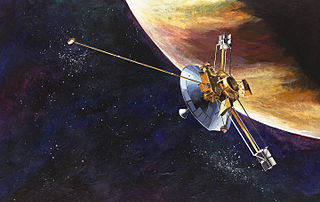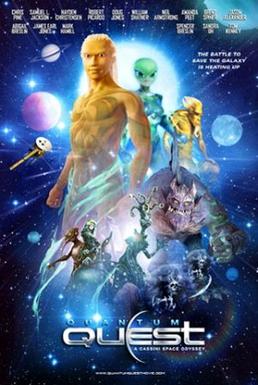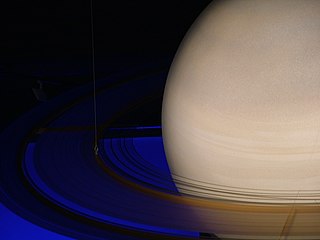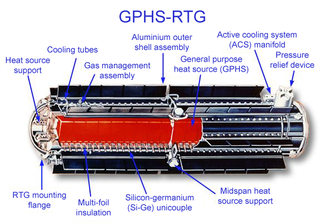
Jet Propulsion Laboratory (JPL) is a federally funded research and development center in Pasadena, California, United States. Founded in 1936 by Caltech researchers, the laboratory is now owned and sponsored by the National Aeronautics and Space Administration (NASA) and administered and managed by the California Institute of Technology.

Cassini–Huygens, commonly called Cassini, was a space-research mission by NASA, the European Space Agency (ESA), and the Italian Space Agency (ASI) to send a space probe to study the planet Saturn and its system, including its rings and natural satellites. The Flagship-class robotic spacecraft comprised both NASA's Cassini space probe and ESA's Huygens lander, which landed on Saturn's largest moon, Titan. Cassini was the fourth space probe to visit Saturn and the first to enter its orbit, where it stayed from 2004 to 2017. The two craft took their names from the astronomers Giovanni Cassini and Christiaan Huygens.

Juno is a NASA space probe orbiting the planet Jupiter. It was built by Lockheed Martin and is operated by NASA's Jet Propulsion Laboratory. The spacecraft was launched from Cape Canaveral Air Force Station on August 5, 2011 UTC, as part of the New Frontiers program. Juno entered a polar orbit of Jupiter on July 5, 2016, UTC, to begin a scientific investigation of the planet. After completing its mission, Juno will be intentionally deorbited into Jupiter's atmosphere.
The New Frontiers program is a series of space exploration missions being conducted by NASA with the purpose of furthering the understanding of the Solar System. The program selects medium-class missions which can provide high science returns.

Claudia Joan Alexander was a Canadian-born American research scientist specializing in geophysics and planetary science. She worked for the United States Geological Survey and NASA's Jet Propulsion Laboratory. She was the last project manager of NASA's Galileo mission to Jupiter and until the time of her death had served as project manager and scientist of NASA's role in the European-led Rosetta mission to study Comet Churyumov–Gerasimenko.

The exploration of Jupiter has been conducted via close observations by automated spacecraft. It began with the arrival of Pioneer 10 into the Jovian system in 1973, and, as of 2023, has continued with eight further spacecraft missions in the vicinity of Jupiter. All of these missions were undertaken by the National Aeronautics and Space Administration (NASA), and all but two were flybys taking detailed observations without landing or entering orbit. These probes make Jupiter the most visited of the Solar System's outer planets as all missions to the outer Solar System have used Jupiter flybys. On 5 July 2016, spacecraft Juno arrived and entered the planet's orbit—the second craft ever to do so. Sending a craft to Jupiter is difficult, mostly due to large fuel requirements and the effects of the planet's harsh radiation environment.

Quantum Quest: A Cassini Space Odyssey is a 2010 animated educational science fiction adventure film, written by Harry 'Doc' Kloor and directed by Kloor and Dan St. Pierre, that takes the viewer on an atomic adventure in space.

The Space Science Institute (SSI) in Boulder, Colorado, is a nonprofit, public-benefit corporation formed in 1992. Its purpose is to create and maintain an environment where scientific research and education programs can flourish in an integrated fashion. SSI is among the four non-profit institutes in the US cited in a 2007 report by Nature, including Southwest Research Institute, Planetary Science Institute, and Eureka Scientific, which manage federal grants for non-tenure-track astronomers.

The exploration of Saturn has been solely performed by crewless probes. Three missions were flybys, which formed an extended foundation of knowledge about the system. The Cassini–Huygens spacecraft, launched in 1997, was in orbit from 2004 to 2017.

GPHS-RTG or general-purpose heat source — radioisotope thermoelectric generator, is a specific design of the radioisotope thermoelectric generator (RTG) used on US space missions. The GPHS-RTG was used on Ulysses (1), Galileo (2), Cassini-Huygens (3), and New Horizons (1).
JunoCam is the visible-light camera/telescope onboard NASA's Juno spacecraft currently orbiting Jupiter. The camera is operated by the JunoCam Digital Electronics Assembly (JDEA). Both the camera and JDEA were built by Malin Space Science Systems. JunoCam takes a swath of imaging as the spacecraft rotates; the camera is fixed to the spacecraft, so as it rotates, it gets one sweep of observation. It has a field of view of 58 degrees with four filters.
Angioletta Coradini was an Italian astrophysicist and planetary scientist.

Jovian Infrared Auroral Mapper (JIRAM) is an instrument on the Juno spacecraft in orbit of the planet Jupiter. It is an image spectrometer and was contributed by Italy. Similar instruments are on ESA Rosetta, Venus Express, and Cassini-Huygens missions. The primary goal of JIRAM is to probe the upper layers of Jupiter's atmosphere down to pressures of 5–7 bars at infrared wavelengths in the 2–5 μm interval using an imager and a spectrometer. The Jupiter's atmosphere and auroral regions are targeted for study. In particular it has been designed to study the dynamics and chemistry in the atmosphere, perhaps determining the how Jovian hot spots form.

Adriana C. Ocampo Uria is a Colombian planetary geologist and a Science Program Manager at NASA Headquarters. In 1970, Ocampo emigrated to California and completed her Master in Sciences at California State University, Northridge and finished her PhD at the Vrije Universiteit in the Netherlands. During high school and graduate studies she worked at the Jet Propulsion Laboratory, where she serves as the science coordinator for many planetary missions.

Amanda R. Hendrix is an American planetary scientist known for her pioneering studies of solar system bodies at ultraviolet wavelengths. She is a senior scientist at the Planetary Science Institute. Her research interests include moon and asteroid surface composition, space weathering effects and radiation products. She is a co-investigator on the Cassini UVIS instrument, was a co-investigator on the Galileo UVS instrument, is a Participating Scientist on the Lunar Reconnaissance Orbiter LAMP instrument and is a Principal Investigator on Hubble Space Telescope observing programs. As of 2019, she is also the co-lead of the NASA Roadmaps to Oceans World Group.

Microwave Radiometer (MWR) is an instrument on the Juno orbiter sent to planet Jupiter. MWR is a multi-wavelength microwave radiometer for making observations of Jupiter's deep atmosphere. MWR can observe radiation from 1.37 to 50 cm in wavelength, from 600 MHz to 22 GHz in frequencies. This supports its goal of observing the previously unseen atmospheric features and chemical abundances hundreds of miles/km into Jupiter's atmosphere. MWR is designed to detect six different frequencies in that range using separate antennas.
The GAVRT Program is a partnership between NASA’s Jet Propulsion Laboratory (JPL) and the Lewis Center for Educational Research (LCER). Based in California, GAVRT is an acronym for the Goldstone-Apple Valley Radio Telescope and provides a science investigation program for students K through 12. Students learn how to be part of a science team while they are making a real contribution to scientific knowledge by operating and collecting data on current NASA JPL missions to moons and planets in the Solar System.
Candice Joy Hansen-Koharcheck is a planetary scientist. She is responsible for the development and operation of the JunoCam, for which she received the NASA's Outstanding Public Leadership Medal in 2018.














